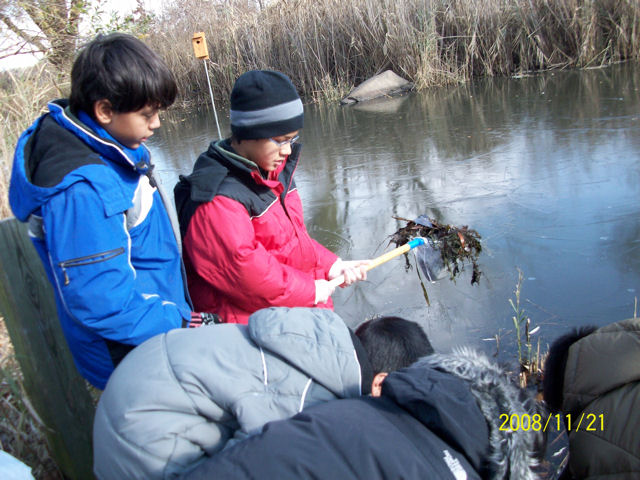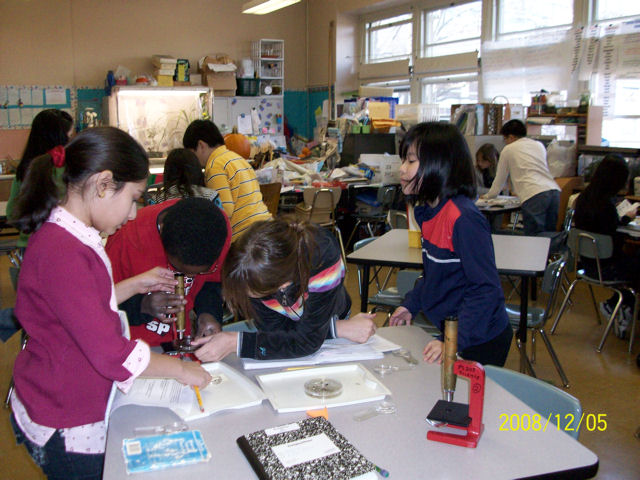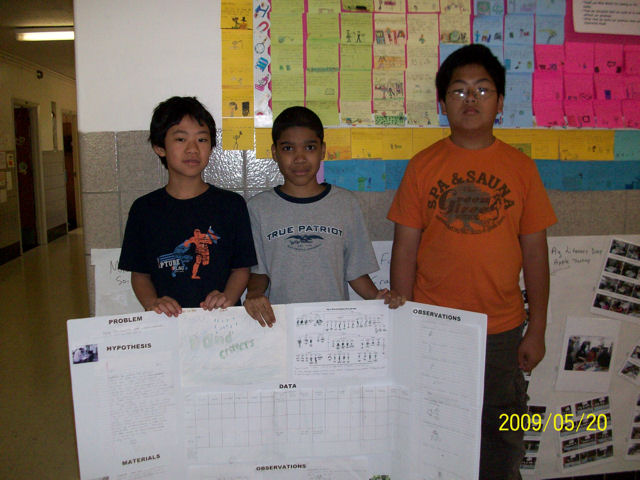Stars and STEM Stories
GLOBE Students Make a Splash in the Big Apple

freshwater invertebrates at Alley Pond Park
Science Cluster teacher Fran Bosi took a leap and jumped in to discover what lurked under the water in a local pond. Employing the GLOBE Freshwater Macroinvertebrate protocol, and working with Peter Schmidt, Associate Director of GLOBE NY Metro, Bosi led two fifth grade classes, from the Alexander Graham Bell School in Bayside Queens, on an investigation involving animals living in a pond at Alley Pond Park. Bosi's school participated in this Environmental Protection Agency ( EPA) funded project, led by GLOBE NY Metro, that equipped teachers to train students to use GLOBE protocols to enhance their research efforts. Students studied specific aspects of the local park's environment and presented findings at a symposium held at Queens College at the end of the school year. The ultimate goals of the program included increasing students' use and appreciation of local parks as well as to improve student inquiry skills leading to more robust research projects.
Classes from Alexander Graham Bell School visited the pond throughout the fall, winter, and spring, keeping a detailed inventory of their findings each trip. During the first outing, the students found their pond covered in a half inch of ice due to the cold November weather. Disappointed by the possibility of not finding anything alive, they gamely used the handles of their nets to break through the ice. There was an expectant silence as Schmidt demonstrated how to scoop into the pond with a net and then deposit retrieved leaves and mud onto a sorting tray. The silence broke abruptly with whoops of surprise and excitement as several large insects bounced up out of the mass of mud and leaves. A mad scramble followed to catch the insects before they returned to the pond.

samples in the warmth of their classroom
After retrieving the insects, Schmidt broke the classes up into small groups to spread out and work independently, and following a few more exclamations of excitement at bouncing bugs, students settled down and began to concentrate on their tasks. While students immediately identified a few caught insects by using an illustrated key to freshwater invertebrates and the Golden Guide to Pond Life, the students brought back every insect caught from the pond to the classroom for a more detailed analysis.
Back in the classroom students worked in small groups as they sorted through their specimens, identified, quantified and recorded their invertebrates. Students expressed a general sense of surprise at the variety and number of organisms living under the ice. The students found Backswimmers, Leeches, Damselfly Larvae, a variety of Diving Beetles, Amphipods, Isopods, several species of Snails, Midge Larvae, and a couple of unidentified segmented worms. In subsequent trips, they added to the list and had a great lesson in food chains when they observed the Dragon Fly Larvae eating some of the Damsel Fly Larvae in the collecting buckets. Students recorded all data and observations in their science journals for reference when they revisited the pond.

a three-season freshwater invertebrate survey
By performing the activity several times, students learned the value of keeping good notes as they observed and recorded seasonal changes in the types and quantities of invertebrates they discovered. Students refined their research skills while also developing a sense of confidence. Several students in each class chose aspects of GLOBE's Freshwater Macroinvertebrate Protocol for their research projects at the school's science fair. The students performed additional research on the value of using biological indicators in the collection of environmental data as well as researching the natural history of several of the species they found.
Near the end of the school year, Bosi and several teams of students from the school came to the EPA/GLOBE Research Symposium at Queens College to present their findings and compare notes with over 150 students from 17 other classes from New York City that participated in the grant program. Since the projects experienced vast popularity among students and received excellent reviews as a catalyst for strong science fair projects, Bosi continues the investigation by leading a new group of students to the park again this year.
Read about more GLOBE activities in New York.
2 April 2010





